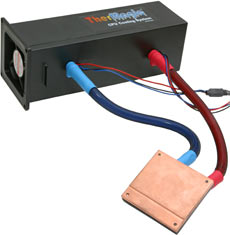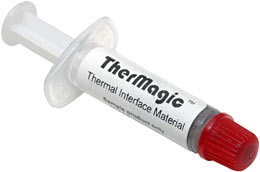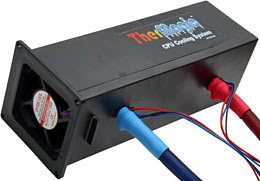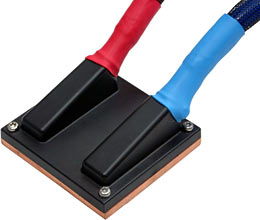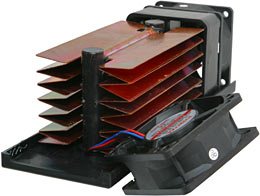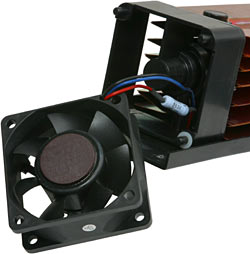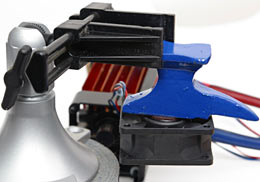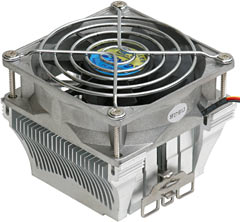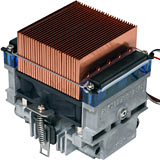
TherMagic CPU Cooling System and Thermal Interface Material
Review date: 4 February 2003. Last modified 03-Dec-2011.
This is the TherMagic CPU Cooling System.
You can't buy it.
That's because it's been recalled by the manufacturer, due to "concerns over long term stability of the product". They only recalled it a few days ago, as I write this. But I'd started the review, so by golly I was going to finish it.
Come on. Look at the thing. I think you can see why I had to finish the review, can't you?
The CPU Cooling System (CCS) is - or was - a simple, plug-and-go, factory-sealed water cooling system for PC CPUs. One water block for the CPU, one twin-fan radiator-plus-pump assembly, all pre-connected with neat-o mesh-wrapped silicone rubber tubing, and ready for installation in your case. You don't even have to pour water into it.
Except for the recently-revealed fact that it may, apparently, stop working at any moment, it looks like a really cool thing.
Unfortunately, as it turns out, you wouldn't want one even if you could buy it.
But I'm getting ahead of myself.
Behold, the other TherMagic product (TherMagic is an Evergreen Technologies label), and the only one that's still on sale. This TherMagic Thermal Interface Material is, according to the PR blurb, "a new class of thermal transfer material referred to as a 'Zero Bondline' interface. This 'Zero Bondline' interface eliminates any structural barrier between the mating surfaces thereby dramatically reducing thermal resistance."
Mm hm.
Since I'd previously compared a variety of different thermal interface materials (or "heat sink greases", in informal parlance), some of which had similarly florid promotional literature, and found that their thermal performance differs by an amount that can be charitably characterised as "three-fifths of bugger all", I was interested to see whether this stuff actually lived up to the hype.
But first, the CCS.
One-step water
The CPU Cooling System has all of the parts of a normal basic PC water cooling rig - a water block that goes on the processor, a radiator, a pump, and hoses. It just all comes pre-assembled, in the one carton.
This "housing assembly" contains the radiator, the pump, and two 60mm fans - one at each end. The fans are fairly ferocious little Evercool EC6025SH12Bs (there are specs here) with 3.96 watt nominal ratings, but only one of them spins at full speed, as we'll see.
The idea is that the TherMagic rig will serve as a decently powerful exhaust fan for your PC, as well as cool your CPU. Good case ventilation helps cool everything in the case, so the theory's sound, but there's no way that these two stacked fans can possibly exceed the free air flow rating of one of them, and that rating is 32.7 cubic feet per minute (CFM). This means that the TherMagic unit probably exhausts air about as well as a basic two watt 80mm case fan.
Its two fans, though, are much louder than a regular case fan; the one spinning at full speed is doing about 6800RPM. One of the reasons for using water cooling is that it lets you make your computer quieter. Not with this thing, it doesn't.
The cold plate for the CPU is a good looking item. There's a hefty slab of copper at the bottom, and nice angled pipe entries. Everything's pre-assembled, and the pipes are held in place with nylon zip ties under heat shrink tubing.
The CCS I got to play with is the Socket A version, which you attach to your CPU socket with a simple three-hole spring clip, like the ones that retain many CPU coolers.
There are also Socket 478 and Socket 423 versions of the CCS, with longer plates and end-clips that match the relevant P4 cooler retaining mechanism.
All three models sold, when they were sold, for $US99. Which is steep for a CPU cooler, but cheap for an all-in-one plug-and-go water cooling system, which can reasonably be expected to perform better than most, if not all, plain air coolers.
A bit of gentle persuasion got the plastic shroud off the radiator and pump assembly. The radiator's a simple pipes-down-the-middle arrangement with only 24 fins, compared with the hundreds or thousands of tiny vanes on most radiators.
Some engineer must have been rather pleased with himself about this.
The pump at the end of the CCS is a magnetically coupled one. That's good; it means the impeller inside has a magnet attached to it, and it's spun by a rotating magnetic field passing through its housing, rather than by a simple shaft from a motor. Shaft-drive pumps need seals around the shaft, and the seals always wear out eventually.
This magnetically coupled pump, though, is driven by a magnet that's attached to the hub of the fan next to it. The fan motor drives both the fan impeller, and the pump. Neat.
Normally, this fan would spin too fast to drive the pump properly, so it's fed through a 15 ohm, three watt resistor, which brings its speed down below 4000RPM.
The pump-drive magnet isn't very powerful; it can just about support the weight of the fan by itself, but that's about it. If you're having some trouble parsing the above image, by the way, the fan is hanging from a very small anvil held in a Model 201 Panavise.
Testing
I am not a complete idiot; before I took the CCS apart, I tested it.
In the installation instructions, which you can still download from here if the urge should strike you, Evergreen say that you're meant to attach the housing assembly to an exhaust fan mounting point on the back of your case. The end of the housing has a flange with holes in the standard 80mm-fan square, and there are two piece plastic expanding-pin "push rivet" fasteners provided for attaching it.
Expanding pin fasteners are stronger than you'd think, as anybody who's tried to just yank off a fan connected with them without popping out the fixing pins will be able to tell you. But I'd still be nervous about hanging the CCS's whole weight from four of them.
Not counting the cold plate - which is, of course, attached to the CPU and not hanging from the pins - the CCS weighs around 690 grams (1.5 pounds), and is about 210mm (8.25 inches) long. An ordinary 80mm case fan, for comparison, isn't likely to weigh more than 80 grams. If I'm going to hang something this size and weight off the back of my case, I'm going to fasten it with nuts and bolts, thanks.
I didn't bother with any of that, though, because I was going to test this thing the same way I test every other CPU cooler.
It was easy enough to attach the cold plate to my CPU-simulating heater block. The provided clip allows the cold plate to move around a bit, but that's a common problem with water block retainers. It works well enough.
Unfortunately, I can't say the same for the CPU Cooling System itself. It makes a lot of noise, but there's not much action; the best thermal resistance score it could manage was 0.73 degrees Celsius per watt (°C/W).
For the benefit of those who haven't waded through my alarmingly gigantic CPU cooler comparison, this score doesn't tell you that this cooling system, installed on a CPU outputting exactly (say) 50 watts, will give you a CPU temperature sensor reading that's 36.5 degrees (50 times 0.73) above ambient. All it tells you is how good the CCS was at cooling my CPU simulator, whose temperature probe is quite close to its heating element, and so tends to give rather high thermal resistance scores.
My test rig is perfectly adequate for comparison purposes, though, and 0.73°C/W is not a good result. It's on par with the results from a lot of very un-glamorous air coolers - this humble Cooler Master one, for instance, or this modest Spire effort. It's also about the same as the results from Thermaltake's flashy Dragon Orb 1; Thermaltake's "orb" coolers all look nifty, but don't work terribly well.
By water cooler standards, 0.73°C/W is rubbish.
When first I saw this craptacular result, I naturally assumed I must have done something wrong. Most likely, I thought my CPU simulator must not have been making good contact with the TherMagic's plate.
But it was. Touching the edge of the plate showed it to be toasty warm. Plenty of heat was getting into it from the heater, and the radiator end of the CCS was blowing a warm breeze. Removing and reattaching the CCS didn't help.
For further verification, I put the CCS aside and put a cooler I'd reviewed earlier in the day back on the heater.
The Spire FalconRock II is a quite cheap cooler with a very quiet one-watt 80mm fan on it, but it works surprisingly well. And it worked surprisingly well once again; with its stock fan, it managed 0.63°C/W, blowing the far, far louder CCS into the weeds.
I, frankly, don't know what the bloody hell Evergreen were thinking when they put the CPU Cooling System on the market. Never mind the recall, and whether it breaks down or not; the thing's just a dog. You'll very probably get better cooling by just installing an exhaust fan where the CCS wants to go and leaving the stock retail CPU cooler on your processor.
There is, however, still one TherMagic product on sale.
The goop
This is a teeny little sample tube of TherMagic Thermal Interface Material. The retail syringes contain 1.5 grams, and are currently selling for $US6.99, ex shipping. That's not a whole lot cheaper than a three gram syringe of Arctic Silver 3, which is what a lot of people reach for when they feel the need for exotic heat sink grease. As I discovered in my earlier comparison, though, you'll get much the same performance from plain old white zinc oxide grease, and you can get a fifty gram syringe of that for less than 1.5 grams of TherMagic.
TherMagic TIM, though, is meant to be special. If a little confusing.
In the TherMagic TIM FAQ (available in PDF format here), it says the stuff "can be used with bare Aluminum, anodized Aluminum, Copper, Silver, plastic, etc", but on the teeny tube I got, there's small print that says "Not for use with bare Aluminum". Um, OK.
My test heater has an aluminium plate and a copper contact patch simulator, and the disc in the bottom of the FalconRock II is copper (the CCS had, in my considered opinion, darn well had its chance), so I decided to chance it with that combination.
My tests so far had been done with some anonymous runny white thermal grease. I cleaned off the old grease with Nasty Solvents (ask for them by name) and replaced it with a similarly thin layer of the TherMagic compound on both sides of the contact patch simulator, and retested the FalconRock II.
Lo and behold, the cooler scored... 0.63°C/W, exactly the same as it had before.
OK, not exactly the same; the actual numbers I recorded varied between test runs, as always, and their average was actually a hair higher. But that difference was below the real resolution of my test rig. There was no statistically significant difference, over a few test runs, between the special TherMagic stuff and the anonymous runny white goop. This is worth mentioning, because of the considerable enthusiasm among Junior Hardware Reviewers for making much of 0.5 point differences between measurements with plus-or-minus two point accuracy.
Some thermal goops work a bit better - or, in the case of semi-solid waxy goops like this stuff, a lot better - after thye've been heated up considerably. They thin out and bed in when they get hot.
In case the TherMagic stuff was such a substance, I turned off the FalconRock's fan and let the heater temperature run up to 110 degrees Celsius, well above the point where a real CPU would have definitely hung, and possibly died.
When I turned the fan back on and let the temperature settle back down, the score had dropped to 0.62°C/W. A 0.01°C/W improvement over un-cooked plain white thermal compound, which can also be expected to work a teeny bit better after it's been briefly overheated.
Now, raw thermal transfer capability isn't the only important specification for heat sink grease. It's also good to have goop that's easier to apply, and/or doesn't dry out. The TherMagic goop is rather viscous, and not particularly easy to apply, but it might last for ages in a hot machine, just like some other "premium" goops. I don't know.
TherMagic promote this stuff as being significantly thermally superior to other goops, though, and I just don't see that. Thermally, it's the same as everything else.
I left the heater assembly with the FalconRock II on it for a day, and then dismantled it and cleaned off the TherMagic TIM. Some of the grey TherMagic grease wouldn't come off under mere solvent and paper towel attack; the aluminium heater plate cleaned up fine, but the bottom of the heat sink and the contact patch simulator each had a little matching indelible streak of grey left on their copper surfaces, which I had to buff off with the usual ultra-fine wet and dry paper.
Whether this signifies something special about this grease, I don't know. The stuff doesn't seem to work any better, though.
Am I nuts?
Not that I don't have the courage of my convictions, or anything, but when I find a product that appears to be rubbish - which the CCS does; the TherMagic grease is just ordinary - I do like to check to see if other reviewers agree.
Well this review and this review of the CCS both conclude as politely as they can that the thing ain't good for much. This one rather likes it, but doesn't compare it with anything else (the author's contacted me now and pointed out that he cut the review short when the recall was announced; fair enough).
But then, there are the reviews that're linked from the TherMagic site. Amazingly enough, they're complimentary.
This one's of the Thermal Interface Material, and it uses a bunch of two-number graphs (please, please read The Visual Display of Quantitative Information, people; using a graph to display two numbers is like using a bus to transport two people...), in which the average temperature difference is less than half a degree Celsius, and in which one test is actually won by Arctic Silver 3. It concludes that the TherMagic stuff is clearly better.
OK, whatever.
And then, there's this one on Monkey Review, which is a piece of good old-fashioned rah-rah nonsense.
[Somewhere in the years since this page first went up, Monkey Review disappeared; as of early 2009 it's a parked domain. I've taken the liberty of reproducing the Monkey Review graphs on this page.]
I've ranted about this sort of thing before, but this one got me going again, when I saw that Monkey Review have found a new way to make an illegible graph:
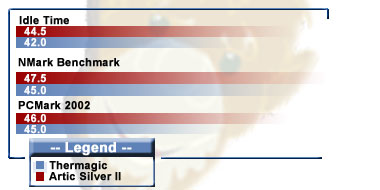
Fading the bars out at the important end. That's innovative.
Plus a gold star for misspelling the name of one of the things you're testing. Outstanding work.
The reviewers, in this case, were good enough to describe their methodology (on this page) and not mention compensating for ambient temperature. Hey, maybe they just forgot to say.
I'm less charitable about logically vapid statements like the one on this page, that "a 2.33 degree drop represents about a 6% drop in temperatures". This only makes even a fragment of sense if the hard deck for your comparison, the ambient temperature, is zero degrees Celsius. I'm figuring that these tests weren't actually performed in a meat locker; if the ambient temperature was a steady 20 degrees Celsius, then the delta-T figures (difference between ambient and CPU temperature, the measurement that tells you what the cooler's really doing) would have been almost twice as large.
Not that that tells you a darn thing about what the practical difference between the coolers is, of course, but... oh, I give up.
One more thing. The resolution-of-0.5 numbers printed in that awful graph, by the way, actually make averages that differ by 2, not 2.33, degrees. But what's a little false accuracy between friends?
The same site had a go at the CCS too, and TherMagic joyously linked to that review as well. The reviewer discovered that the CCS pretty much level-pegged with a Thermaltake Volcano 9 (say hello to another ghastly graph...
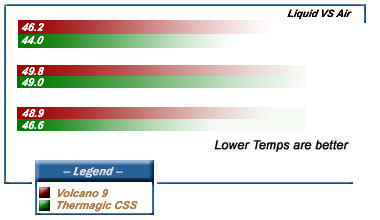
...containing another product-name typo...), and then concluded that despite the fact that the water cooling rig cost more than twice as much, made more noise and was harder to install, they nonetheless "couldn't have asked for anything more".
Well, I bloody well could. Don't know about you.
I review the Volcano 9, by the way, here. It's not a bad variable-fan-speed cooler, and it's very widely available. But even with its fan running at its noisy full-power setting, the V9 only works a bit better than the FalconRock II, which is rather quieter than the average power-supply fan.
Overall
My review TherMagic stuff came from Yen Industries here in Australia, but they don't sell either product at the moment. They're not likely to start selling the withdrawn CCS, of course, but it would appear that there's no reason to go out of your way to find the TherMagic grease, either. Arctic Silver 3's cheaper per cubic centimetre, if you want a premium grease; otherwise, use whatever white stuff you like, and don't worry about it.
Evergreen say that CCS sales have only been "temporarily suspended"; if they intend to re-launch the product, let's hope they seriously revise it first. The CCS is supposed to provide "low cost, high performance cooling in a package practical for installation by even the novice computer user"; well, it is pretty easy to install, but it's not low cost or high performance, and it makes an obnoxious racket.
Feh.
Another failure
Here's another stab at this same idea. Allow me to spoil the surprise: It's no better.
